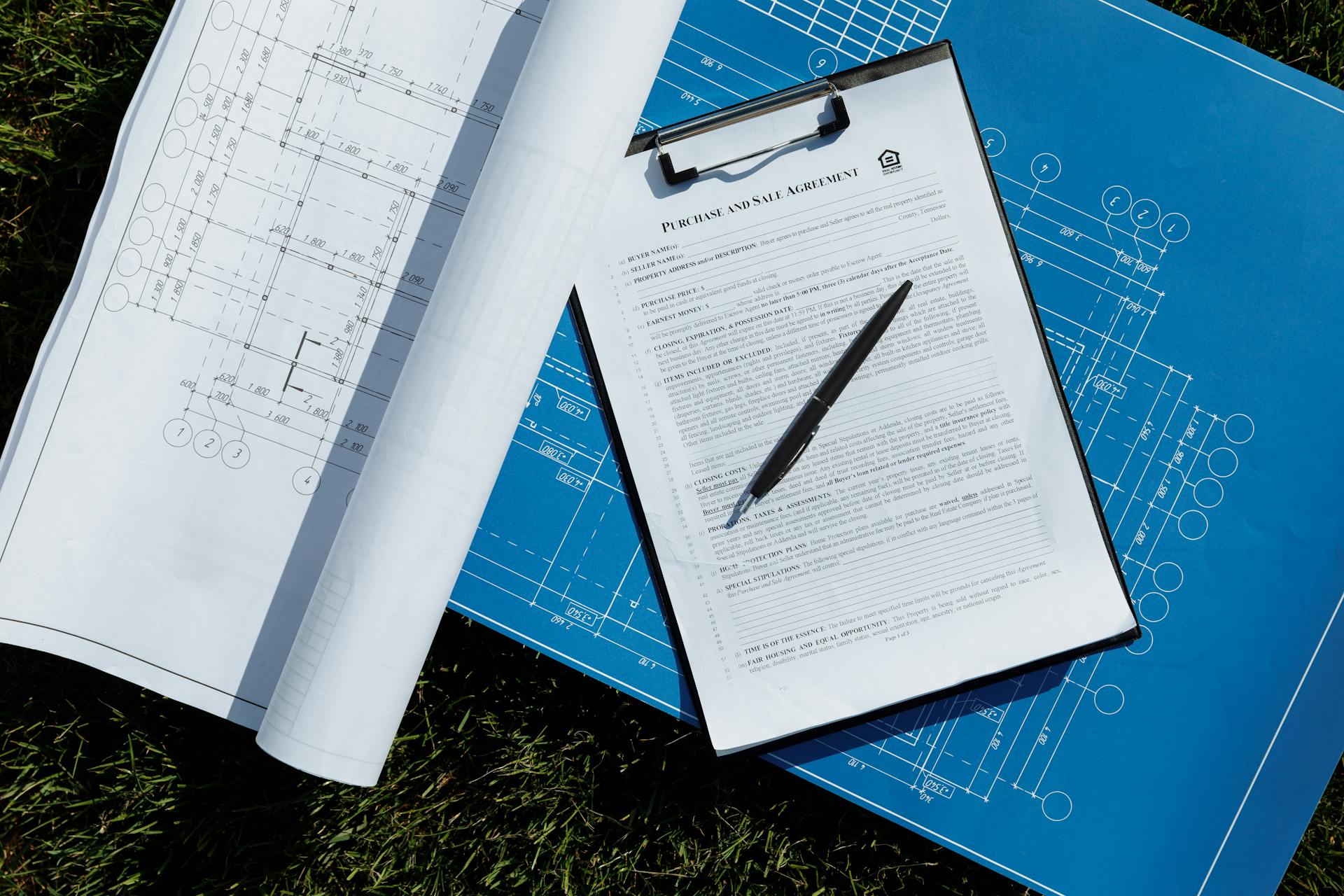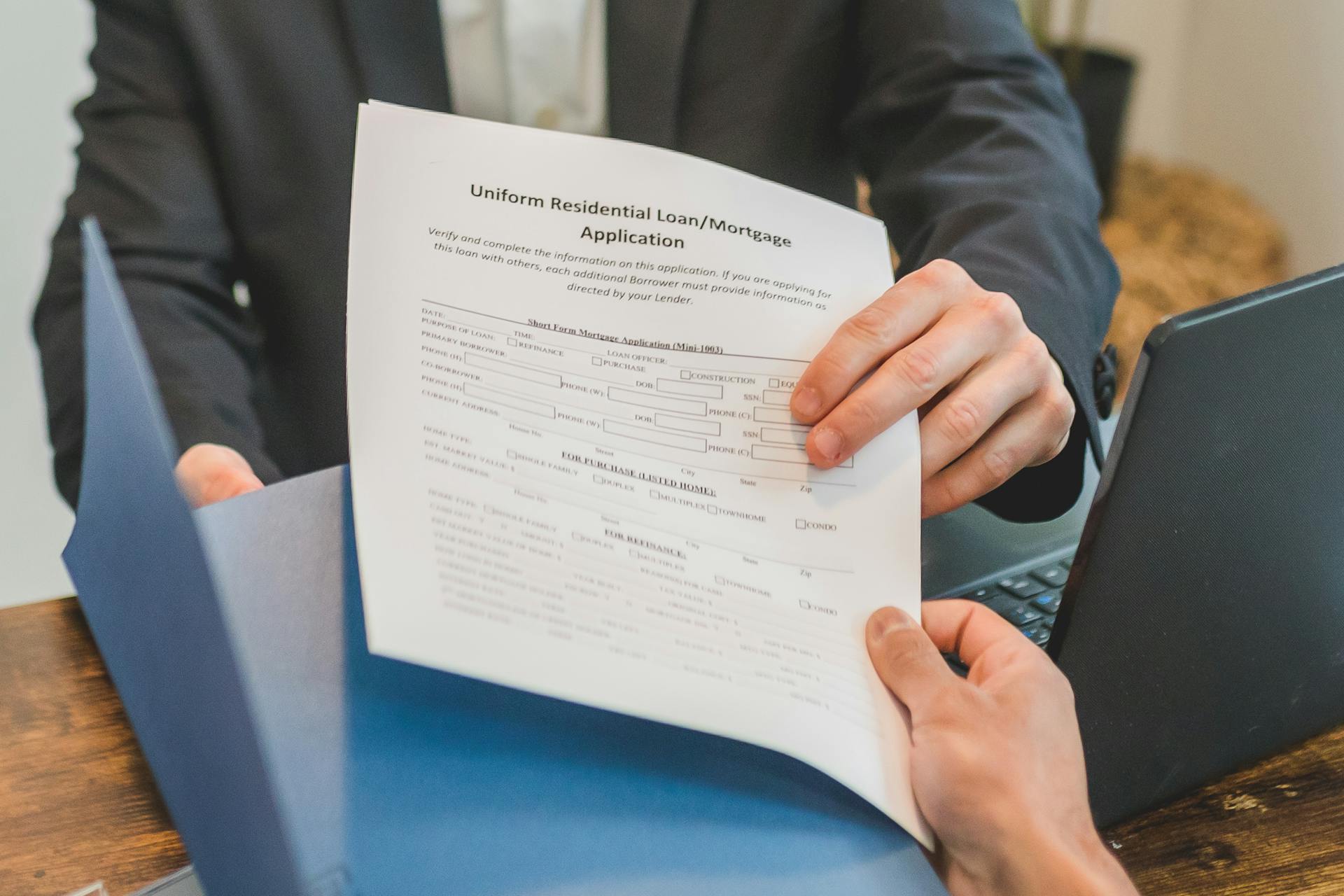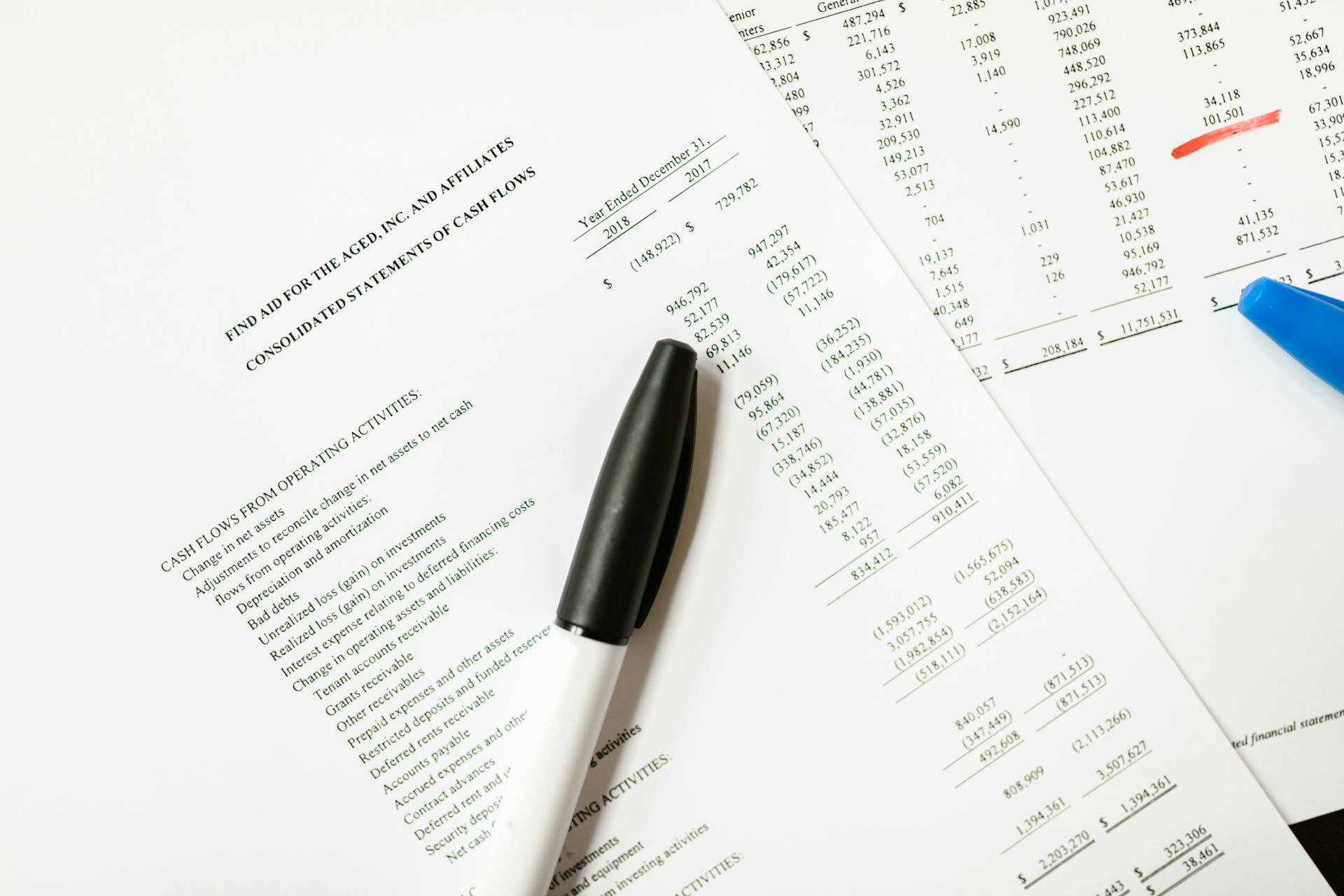
An underwriting agreement is a crucial document that outlines the terms and conditions of a securities offering. It's a legally binding contract between the issuer and the underwriter.
The underwriting agreement typically includes a description of the securities being offered, the offering price, and the number of shares being issued. This information is essential for investors and regulators.
In addition, the agreement outlines the underwriter's responsibilities, such as marketing the securities and managing the offering process. The underwriter's fees and expenses are also specified in the agreement.
The underwriting agreement is a critical component of the securities offering process, and it's essential that all parties involved understand its terms and conditions.
Consider reading: Homeowners Insurance Underwriting Process
Agreement Structure
An underwriting agreement is a contract between an issuer and an underwriter that outlines the terms and conditions of the sale of securities. The structure of this agreement is crucial to ensure a smooth transaction.
The underwriting agreement typically includes several key elements, such as the definition of the underwriter, the issuer's representations and warranties, conditions precedent, indemnification, and confidentiality agreements. These elements are essential to protect the interests of both parties involved.
A clear understanding of the underwriting process is also vital in structuring the agreement. This includes understanding the roles and responsibilities of the parties involved, such as the underwriter's obligation to purchase securities from the issuer and sell them to investors.
Here's an interesting read: Which of the following Describes the Securities Underwriting Process
Offer Terms

The Offer Terms section of the underwriting agreement is where the details of the securities offering are outlined. This includes the type of security offered, the number of securities offered, and the offering price.
The underwriter and company must determine the type of security offered, such as common stock or bonds, and the number of securities offered in the underwriting agreement. This will help to establish the total amount of capital being raised.
Decide on the offering price of the securities listed in the agreement. This price is typically set by the underwriters based on market conditions, demand for the securities, and other factors.
Establish a timeline for the offering period. This will help to ensure that the offering is completed within the desired timeframe.
Decide on the fees associated with the offering. These fees can include the underwriting discount, commissions, and other expenses.
Decide on the conditions that must be met before the offering is closed. This may include requirements for the company's financial statements, regulatory approvals, or other milestones.
Discover more: A Life Insurance Producer's Underwriting Duties May Include
Here is a summary of the key points to consider when determining the offer terms:
- Type of security offered
- Number of securities offered
- Offering price
- Timeline for the offering period
- Fees associated with the offering
- Conditions that must be met before the offering is closed
By carefully considering these factors, the underwriter and company can ensure that the offer terms are fair, reasonable, and in the best interest of all parties involved.
Form of the
When drafting the form of an underwriting agreement, it's essential to consult with legal counsel to determine the specific requirements for the transaction. This ensures that the agreement is tailored to the unique needs of the parties involved.
To create a comprehensive agreement, you'll need to draft it in accordance with applicable law and financial regulations. This includes including all the relevant terms and conditions of the agreement.
The form of the agreement should be carefully crafted to include every necessary detail. This includes having the necessary parties sign the agreement, which confirms their commitment to the terms outlined.
Here's a step-by-step guide to creating the form of the underwriting agreement:
- Consult with legal counsel to determine what form of underwriting agreement is needed for the specific transaction
- Draft the agreement in accordance with applicable law and financial regulations
- Include all the relevant terms and conditions of the agreement
- Have the necessary parties sign the agreement
Once all parties have signed the agreement, you can check this off your list and move on to the next step of risk analysis.
Key Elements
An underwriting agreement is a crucial document that outlines the terms and conditions of a securities offering. It's essentially a contract between the issuer and the underwriter that spells out the responsibilities and obligations of both parties.
The purpose of an underwriting agreement is to ensure that both the issuer and the underwriter understand their roles and responsibilities. This agreement typically includes the basic components of the offering, such as the type of security being issued and the number of securities being issued.
The underwriter plays a crucial role in the offering process, and their responsibilities are clearly outlined in the agreement. The issuer, on the other hand, is responsible for providing accurate information about the company and the offering.
The underwriting agreement also specifies the terms of the offer, including the price and any other relevant details. This information is essential for investors to make informed decisions about the offering.
The agreement includes representations and warranties of the issuer and the underwriter, which are critical in ensuring that both parties are held accountable for any inaccuracies or misrepresentations. These representations and warranties are often highly negotiated in each deal.
The lead underwriter usually exerts the most control over the terms of the underwriting agreement. The agreement also includes provisions related to indemnification and liability, which protect both parties in case of any disputes or issues.
Here are the key elements of an underwriting agreement:
- Understand the purpose of an underwriting agreement and its basic components
- Define the roles of the underwriter and issuer
- Identify the type of security being issued
- Specify the number of securities being issued and the terms of the offer
- Include representations and warranties of issuer and underwriter
- Establish procedures for completion of the offering
- Detail the compensation of the underwriter
- Set forth the obligations of the parties
- Include provisions related to indemnification and liability
- Include provisions related to termination of the agreement
Representations and Obligations
The "Representations and Obligations" section of the underwriting agreement is crucial, as it outlines the promises and commitments made by the issuer to the underwriters. The issuer must make a number of representations and warranties, including statements about the accuracy of financial statements.
These representations and warranties can be significant, as they may include statements about compliance with applicable laws and regulations, and the absence of material adverse changes. It's essential for issuers to carefully review and negotiate these provisions to avoid any potential liability.
The underwriters may require the issuer to indemnify them against any losses or damages resulting from any misrepresentations or omissions in the offering materials. This can be a significant risk for issuers, so it's vital to negotiate favorable indemnification terms.
A different take: National Association of Health Underwriters
Representations and Warranties
Representations and warranties are a crucial part of any agreement, and they must be clearly described to ensure that all parties understand their rights and obligations. They are assertions about the accuracy of facts, and parties present them to induce others to enter into a contract.
Representations and warranties are usually heavily negotiated, and they can have a significant impact on the success of a transaction. For example, in an underwriting agreement, the company may represent and warrant that it has complied with all applicable laws and regulations.
The parties to an agreement must provide any necessary evidence to substantiate their representations and warranties. This can include financial statements, contracts, or other documents that demonstrate the accuracy of the representations.
Once all the representations and warranties have been listed out, authenticated, and signed, the parties can move on to the next step. It's essential to confirm that all parties have had the opportunity to review the representations and warranties and that they understand their implications.
Here are some examples of representations and warranties that may be included in an underwriting agreement:
- The company represents and warrants that it has complied with all applicable laws and regulations.
- The company covenants with each underwriter to carry out or not carry out certain specified activities.
- The company warrants that it has the authority to enter into the agreement.
In addition to these examples, there may be other representations and warranties that are specific to the transaction or agreement. It's essential to carefully review and negotiate these provisions to avoid any potential liability down the road.
Conditions to Underwriters' Obligations
The conditions to the underwriters' obligations are a crucial part of the underwriting agreement. These conditions ensure that the underwriters are protected and that the issuer meets certain requirements.
To deliver the necessary documents, the issuer must provide a negative assurance letter from the company's auditor, confirming the accuracy of certain facts. This letter is essential to avoid costly litigation down the road.
Underwriters also require an opinion letter from the law firm representing them, which attests to the validity of various legal descriptions. This opinion letter helps to ensure that the underwriting agreement is legally sound.
Consider reading: Why Has My Loan Application Gone to the Underwriters
The underwriters' obligations are conditional upon the issuer's compliance with these requirements. If the issuer fails to meet these conditions, the underwriters may be released from their obligations.
Here are the key documents required to satisfy the underwriters' obligations:
- Negative assurance letter from the company's auditor
- Opinion letter from the law firm representing the underwriters
By understanding these conditions and requirements, issuers can ensure that they meet the underwriters' obligations and successfully bring their securities to market.
Issuer's Role
As the issuer, you have a crucial role to play in the underwriting process. You're responsible for providing accurate and complete information about the securities and your company to the underwriters and the public.
You must make a number of representations and warranties in the underwriting agreement, including statements about the accuracy of financial statements, compliance with applicable laws and regulations, and the absence of material adverse changes. This can be a significant responsibility, so it's essential to carefully review and negotiate these provisions to avoid any potential liability down the road.
Here's an interesting read: Do Underwriters Check Bank Statements before Closing

The issuer is also responsible for ensuring that the securities are priced appropriately and that the offering is conducted in compliance with regulatory requirements. This includes understanding the purpose of an underwriting agreement and its basic components, such as defining the roles of the underwriter and issuer, identifying the type of security being issued, and specifying the number of securities being issued and the terms of the offer.
Here are some key responsibilities of the issuer:
- Provide accurate and complete information about the securities and the company
- Make representations and warranties in the underwriting agreement
- Ensure securities are priced appropriately
- Conduct the offering in compliance with regulatory requirements
As the issuer, you must also be aware of the key terms and conditions of the underwriting agreement, such as the price at which the securities will be sold to the public, representations and warranties, indemnification, termination, and lock-up agreements. Understanding these terms and conditions is critical to ensuring the success of the offering and protecting your interests.
Financial and Regulatory
To create a successful underwriting agreement, you need to consider both the financial and regulatory aspects of the transaction. Determining the required capital is a crucial step in the process.
You'll need to identify the sources of the required capital, evaluate the financial terms of the transaction, and negotiate and agree upon the terms of the financial transaction. This includes recording the details of the financial transaction in the underwriting agreement.
Researching and analyzing relevant regulatory requirements for the underwriting agreement is also essential. This involves consulting with a legal expert to ensure the agreement is compliant with all applicable laws and regulations.
Here are the key steps to address financial and regulatory considerations:
- Determine how much capital is required to complete the transaction
- Identify the sources of the required capital
- Research and analyze relevant regulatory requirements for the underwriting agreement
- Consult with a legal expert to ensure the agreement is compliant with all applicable laws and regulations
Once you've addressed these considerations, you can record the agreed-upon terms in the underwriting agreement and check off this step on your list.
Financial Considerations
Financial considerations are a crucial part of the underwriting agreement. You'll need to determine how much capital is required to complete the transaction.
To do this, you'll need to identify the sources of the required capital. This could include investors, loans, or other forms of financing. Evaluate the financial terms of the transaction, including the risks and potential returns.
Negotiate and agree upon the terms of the financial transaction, taking into account the interests of both the issuer and the underwriter. Record the details of the financial transaction in the underwriting agreement.
Here's a summary of the key points to consider:
- Determine the required capital for the transaction.
- Identify the sources of the required capital.
- Evaluate the financial terms of the transaction.
- Negotiate and agree upon the terms of the financial transaction.
- Record the details of the financial transaction in the underwriting agreement.
Once all of the financial considerations have been addressed, you can record the agreed-upon terms in the underwriting agreement and move on to the next step.
Conditions Precedent
Conditions Precedent are a crucial part of any securities issuance. They are the conditions that must be fulfilled before the company can issue the securities.
To identify the Conditions Precedent, you need to look at the specific requirements outlined in the agreement. These requirements typically include the delivery of certain documents, such as a negative assurance letter from the company's auditor.
A negative assurance letter is a confirmation from the auditor that certain facts are accurate. This helps to avoid costly litigation down the road.
The Conditions Precedent also specify the date by which these conditions must be satisfied. This is usually a specific deadline that the company must meet.
Here are the typical steps involved in fulfilling the Conditions Precedent:
- Identify what conditions must be fulfilled before the company can issue the securities
- Determine any conditions that must be satisfied by the issuer or other parties
- Specify the date that conditions must be satisfied by
- Outline any actions the issuer and other parties must take to satisfy conditions
- Describe the consequences if conditions are not satisfied
- Review the conditions precedent to ensure they are legally valid
Once all Conditions Precedent have been satisfied, you can check this off your list and move on to the next step.
Underpricing
To establish an underpricing agreement, you need to estimate the maximum number of shares to be sold and the pricing range of those shares. This will help determine the underpricing amount.
You'll then calculate the underpricing amount based on the estimated number of shares and the pricing range. This involves setting a minimum offering price for the shares.
Next, you'll determine the maximum amount of shares that can be sold at the minimum offering price. This will help you establish the terms of the underpricing agreement.
To finalize the underpricing agreement, you'll need to establish the terms of the underpricing agreement. This will involve setting a minimum offering price and determining the maximum amount of shares that can be sold at that price.
Here's a step-by-step breakdown of the underpricing process:
- Estimate the maximum number of shares to be sold and the pricing range of those shares
- Calculate the underpricing amount based on the estimated number of shares and the pricing range
- Set a minimum offering price for the shares
- Determine the maximum amount of shares that can be sold at the minimum offering price
- Establish the terms of the underpricing agreement
- Finalize the underpricing agreement
Regulatory Requirements
Researching regulatory requirements is a crucial step in ensuring the underwriting agreement complies with all applicable laws and regulations. This involves researching the securities laws and regulations that govern the agreement and the securities being offered.
To confirm compliance, you need to review the agreement and the offering to ensure they meet all relevant laws and regulations. This includes checking for any prohibited terms and confirming that the agreement does not violate any other applicable laws or regulations.
Prohibited terms can be a major issue, so it's essential to carefully review the agreement and the offering to ensure they comply with all laws and regulations.
Here are the key steps to confirm regulatory compliance:
- Research the applicable securities laws and regulations that govern the underwriting agreement and the securities being offered
- Confirm that the agreement and the offering comply with all relevant laws and regulations
- Confirm that the underwriting agreement does not contain any prohibited terms
- Confirm that the agreement does not violate any other applicable laws or regulations
By following these steps, you can ensure that your underwriting agreement is compliant with all regulatory requirements, giving you peace of mind and protecting your business from potential risks.
The Greenshoe Option
The Greenshoe Option is a provision in the underwriting agreement that allows underwriters to sell investors more shares than initially planned.
This provision is particularly useful when demand for the company's shares is higher than expected, as it gives the underwriters the flexibility to meet the excess demand.
The greenshoe option typically states that investors may buy up to 15% more than the initial number of shares.
This means that if the initial number of shares is 100,000, investors can buy up to 115,000 shares with the greenshoe option in place.
Negotiation and Execution
Negotiation and Execution is a crucial step in the underwriting agreement process. It involves confirming all parties have reviewed the prospectus and are ready to proceed.
To confirm readiness, make sure all parties have reviewed the prospectus. This document outlines the terms and conditions of the securities issue.
The negotiation process involves gathering relevant documents, such as the prospectus, subscription agreement, and any other legal documents. These documents provide a framework for the negotiation.
Discover more: Cyber Insurance Underwriting
Key points to consider during negotiations include the purchase price, the number of shares, any conditions or warranties, and the fees and commissions. It's essential to discuss and agree on these terms to ensure a smooth transaction.
Here are the key steps to execute the underwriting agreement:
- Confirm all parties have reviewed the prospectus and are ready to proceed
- Negotiate the terms of the underwriting agreement, including the underwriting discount, the number of shares to be issued, and the due diligence process
- Draft the underwriting agreement and submit it to the underwriter for review
- Execute the underwriting agreement and submit the signed agreement back to the issuer
Once the agreement is executed, you will know you have completed this step when the underwriting agreement has been executed by all parties involved.
Party Negotiations
Party negotiations are a crucial step in the underwriting process. It's essential to gather all relevant documents, such as the prospectus, subscription agreement, and any other legal documents, to ensure a smooth negotiation process.
Discussing the terms of the underwriting agreement with the other party is vital. This includes the purchase price, the number of shares, any conditions or warranties, and the fees and commissions.
You'll need to exchange drafts of the underwriting agreement until both parties are in agreement. This back-and-forth process can be time-consuming, but it's necessary to ensure that both parties are on the same page.

Make sure to include any amendments or changes to the agreement that both parties have agreed to. This will help prevent any misunderstandings or disputes down the line.
Here are the key steps to follow during party negotiations:
- Gather all relevant documents, such as the prospectus, subscription agreement, and any other legal documents
- Discuss the terms of the underwriting agreement with the other party
- Exchange drafts of the underwriting agreement until both parties are in agreement
- Include any amendments or changes to the agreement that both parties have agreed to
Once all negotiations have been finalized and the terms of the underwriting agreement are mutually agreed upon, the agreement is ready to be executed. This is an exciting milestone in the underwriting process!
Understand the Process
Understanding the process of negotiation and execution is crucial for a successful business deal. It's essential to know your counterparty, which means researching their capacity to fulfill the terms of the agreement.
Research the counterparty to ensure they have the capacity to properly fulfill the agreement. This includes looking into any past legal disputes between the parties, as well as their financial information to ensure they have the stability to fulfill the agreement.
Make sure the counterparty is authorized to enter into the agreement and has the legal capacity to understand the agreement. This is a critical step in ensuring a smooth negotiation process.
Once you're satisfied with the counterparty's ability to fulfill the agreement, you can move on to understanding the underwriting process. This involves reading up on the process and related definitions, as well as familiarizing yourself with the roles of the parties involved.
The underwriting process is complex and involves many parties, including the underwriter and the issuer. Research any applicable laws and regulations that are related to the underwriting process to ensure you're in compliance.
Understand the pricing of the securities, any underwriting fees, and the commission structure. This will help you make informed decisions throughout the negotiation process.
Here are some key roles to consider in the underwriting process:
Understanding the underwriting process and the roles of the parties involved will help you navigate the negotiation and execution process with confidence.
Termination and Mitigation
To terminate an underwriting agreement, you'll need to draft a termination clause that outlines the conditions and procedures for ending the agreement. This clause should specify the circumstances under which the agreement can be terminated by either the issuer or the underwriter.
The termination clause should include provisions for the release of any funds that have been held in escrow. Reviewing applicable laws and regulations is also crucial to ensure compliance with relevant requirements.
A termination clause should also outline the consequences of termination, such as any payments that need to be made and the date of termination. It's essential to include a clause that outlines how the termination clause will be enforced if either party does not comply.
Here are the key points to consider when drafting a termination clause:
- Outline the circumstances under which the agreement can be terminated
- Specify the type of notice that should be given by either party in the event of a termination
- Include a clause that outlines the consequences of termination
- Outline how the termination clause will be enforced
- Include a clause that states the parties' acknowledgement that the termination clause is binding
Termination
Termination is a critical aspect of an underwriting agreement, and it's essential to have a clear understanding of the process and procedures involved.
To draft a termination clause, you should outline the conditions and procedures for ending the underwriting agreement, which may include provisions for the release of any funds held in escrow.
The termination clause should be reviewed for compliance with applicable laws and regulations, and it's recommended to consult with legal counsel to ensure it meets all the necessary requirements.

A well-drafted termination clause should specify the circumstances under which an underwriting agreement can be terminated by either the issuer or the underwriter.
In the event of termination, the parties should provide a specified type of notice, and the consequences of termination should be clearly outlined, including any payments that need to be made and the date of termination.
To ensure compliance, the termination clause should outline how it will be enforced if either party fails to comply.
If a breach of the underwriting agreement occurs, either party may terminate the agreement, and the remedies for breach should be specified, including the right to recover damages.
In the event of termination due to breach, provisions should be made for the transfer of rights and obligations, as well as the disposition of funds paid into escrow.
To reinstate the agreement after a breach has been cured, the parties should include a provision that allows for the reinstatement of the agreement.
Here are some key points to consider when drafting a termination clause:
- Draft a termination clause that outlines the conditions and procedures for ending the underwriting agreement
- Consider including provisions for the release of any funds that have been held in escrow
- Review any applicable laws and regulations to ensure the termination clause complies with any relevant requirements
- Specify the circumstances under which an underwriting agreement can be terminated by either the issuer or the underwriter
- Include a clause that outlines the consequences of termination, such as any payments that need to be made and the date of termination
- Outline how the termination clause will be enforced if either party does not comply
- Include a clause that states the parties’ acknowledgement that the termination clause is binding
Mitigation of Risk
Mitigation of risk is a crucial step in the underwriting process. It involves identifying and addressing potential risks associated with the issuer and the offering.
To mitigate risk, underwriters must analyze the issuer's ability to manage identified risks. This requires a thorough examination of the issuer's resources and capabilities.
Drafting provisions in the underwriting agreement to address risks is also essential. These provisions should be enforceable and consistent with any applicable regulations.
Underwriters must also ensure that the agreement covers all identified risks. This involves reviewing the agreement carefully to ensure that no potential risks have been overlooked.
Here are some key steps to mitigate risk in underwriting agreements:
- Identify the risks associated with the issuer and the offering
- Analyze the issuer’s ability to manage the identified risks
- Determine the issuer’s resources for mitigating the risks
- Draft provisions in the underwriting agreement to address the risks
- Ensure the provisions are enforceable and consistent with any applicable regulations
- Check the agreement to make sure it covers all the risks identified
By following these steps, underwriters can effectively mitigate risk and protect themselves and their clients from potential losses.
Best Practices and Compliance
When reviewing an underwriting agreement, it's essential to carefully review the agreement to ensure its accuracy and that it protects the interests of both parties involved.
To ensure accuracy, review the agreement thoroughly, checking for any discrepancies or omissions. This will help prevent potential issues down the line.
Make sure the agreement clearly states the amount of the offering, the underwriter's fee, and the responsibilities of both parties. This transparency is crucial for a successful partnership.
The agreement should also specify the scope of the indemnification obligations of each party. This will help prevent misunderstandings and ensure both parties are held accountable.
To ensure compliance, identify any restrictions or conditions imposed on the offering, such as a minimum subscription amount or a maximum offering size. These conditions can significantly impact the success of the offering.
Here are some key elements to include in the underwriting agreement:
- Carefully review the agreement to ensure accuracy
- Stated the amount of the offering, the underwriter’s fee, and the responsibilities of both parties
- Identified any restrictions or conditions imposed on the offering
- Included provisions regarding marketing, due diligence, and public disclosure
- Included details regarding the settlement process
- Specified the scope of the indemnification obligations of each party
By including these essential elements, you can ensure a solid foundation for a successful underwriting agreement.
Risks and Benefits for Underwriters and Investors
Underwriting agreements come with potential risks and benefits for both underwriters and investors.
Underwriters face market risk, which means they can lose money if market conditions change and they can't sell securities at the agreed-upon price.
Underwriters also face legal risk, as they can be held liable for losses incurred by investors if the company they underwrite makes false or misleading statements in the prospectus.
Reputation risk is another challenge for underwriters, as a failed or fraudulent offering can damage their reputation in the market.
Underwriters receive fees for their services, which can be substantial, usually a percentage of the total amount of securities sold.
On the other hand, investors face market risk, which means they can lose money if market conditions change and the value of their securities decreases.
Investors may also face liquidity risk, making it difficult to sell their securities when they need to, resulting in losses if they're forced to sell at a lower price.
Investors can also face legal risk if the company they invest in makes false or misleading statements in the prospectus, making it difficult to recover losses.
Investors, however, can benefit from the potential for high returns, as successful companies can increase the value of their securities.
Underwriting agreements also provide investors with transparency, allowing them to make informed investment decisions with detailed information about the company's business and financials.
Check this out: Market Watch Hometap Home Equity Agreement
IPO Process
The IPO process can be complex, but it starts with the underwriting agreement. This agreement outlines the terms and conditions of the IPO, including the number of shares being offered, the price per share, and the responsibilities of each party involved.
The underwriting agreement is designed to protect the company from potential risks associated with going public. The underwriter(s) agree to purchase the shares from the company at an agreed-upon price, providing the company with a guaranteed source of funding.
There are two main types of underwriting agreements: firm commitment and best efforts. In a firm commitment underwriting agreement, the underwriter(s) agree to purchase all of the shares being offered by the company, regardless of whether or not they can resell them to the public.
The underwriter(s) work with the company to determine the initial offering price of the shares and allocate them to institutional investors, retail investors, and other interested parties. This process helps to ensure that the IPO is successful and that the shares are priced appropriately.
The underwriter(s) provide support and guidance throughout the IPO process, helping the company navigate the complex regulatory environment and providing advice on marketing and investor relations. This support is crucial for ensuring that the IPO is successful and that the company is able to achieve its goals.
The underwriting agreement is a critical document in the IPO process, providing important protections for the company and ensuring regulatory compliance.
Frequently Asked Questions
What are the three types of underwriting?
There are three main types of underwriting: loan underwriting, insurance underwriting, and securities underwriting. These types involve evaluating risk and determining eligibility for financial products.
What is an underwriting agreement IPO?
An underwriting agreement in an IPO is a contract between an investment bank and the company, where the bank evaluates the risks and agrees to buy shares at a set price to resell to investors. This agreement is a crucial step in the IPO process, ensuring the company's shares are sold to investors at a fair price.
Sources
- https://www.investopedia.com/terms/u/underwriting-agreement.asp
- https://www.genieai.co/en-us/blog/writing-an-underwriting-agreement
- https://www.netlawman.co.in/d/underwriting-agreement
- https://carpenterwellington.com/post/underwriting-agreement-important/
- https://fastercapital.com/content/Underwriting-agreement--Exploring-the-Final-Prospectus-and-its-Key-Players.html
Featured Images: pexels.com


